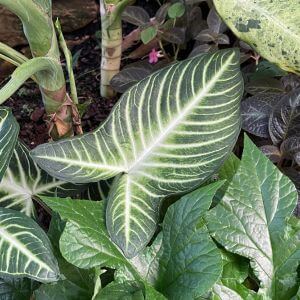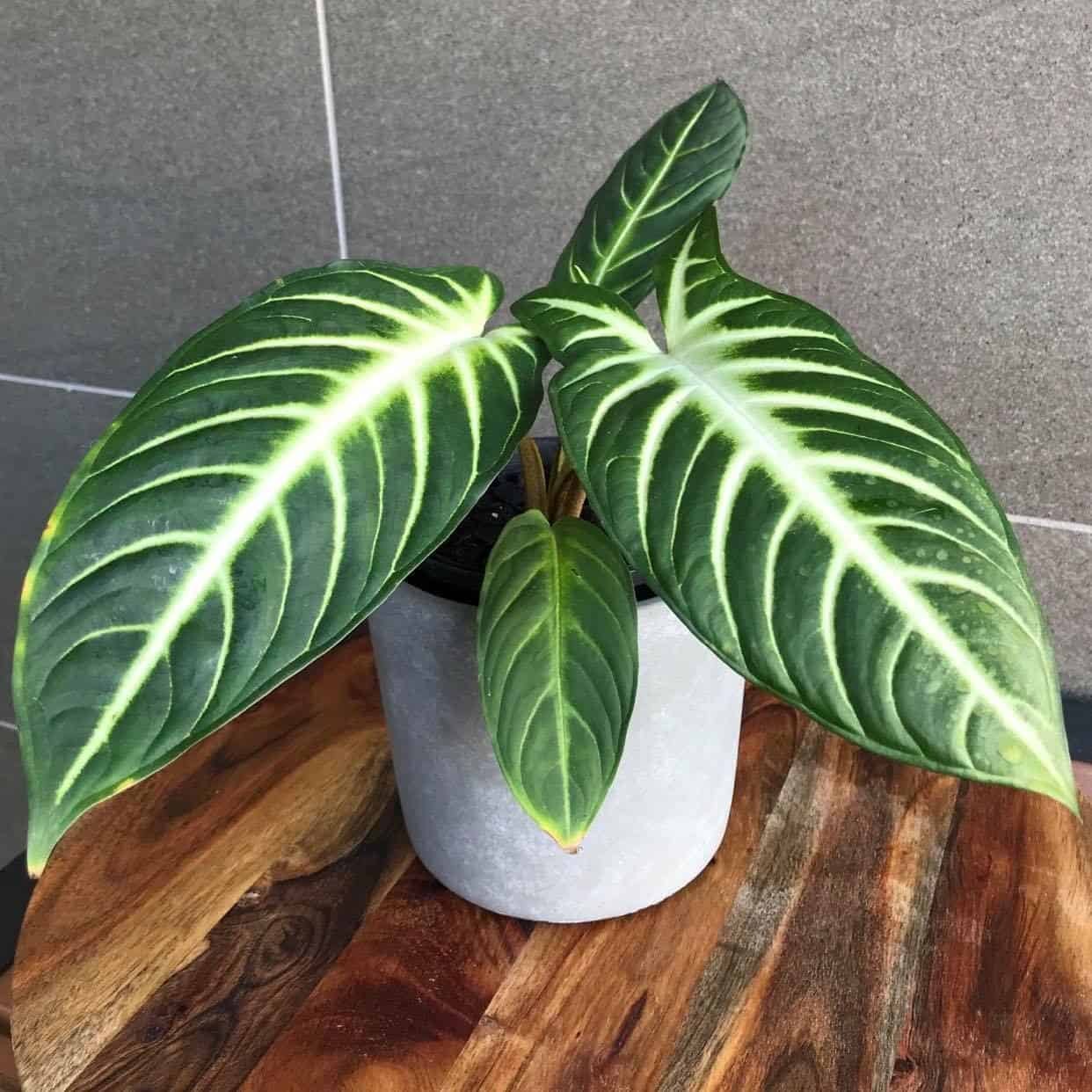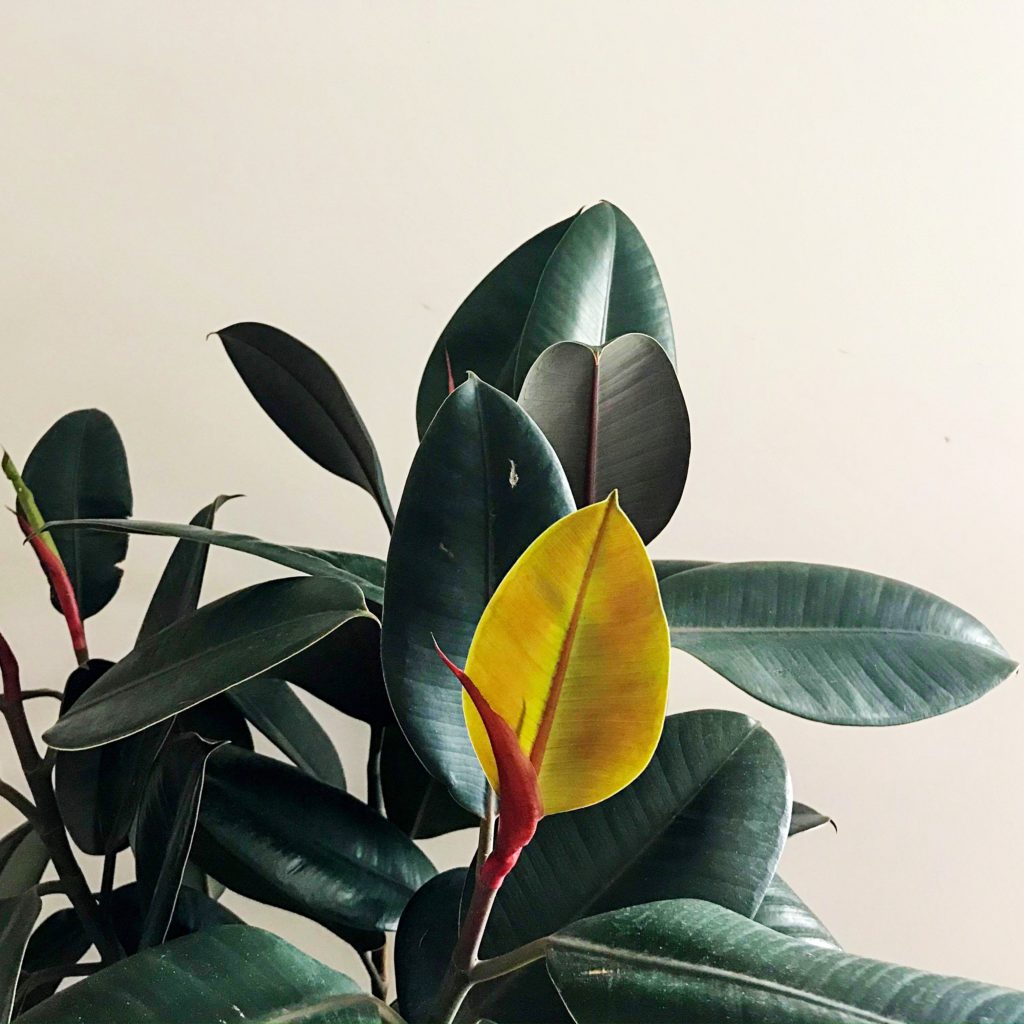
Xanthosoma Lindenii ‘Magnificum’ aka Angel’s Wings
Caladium Lindenii Quick Overview
| Full Size | 2-3 Feet |
| Light | Bright Indirect |
| Temperature | 70˚F (21˚C). |
| Humidity | High |
| Cost | $ |
| Care Level | Easy |
| Toxicity | Toxic |
Xanthosoma Lindenii ‘Magnificum’ (Caladium Lindenii) are a part of the Araceae family that is native to Columbia. They can be identified by their large, green, arrowhead shaped leaves with prominent white/cream coloured veins.
Most commonly known as the ‘Angel Wing’ plant amongst house plant fanatics for its unique, stand-out patterning. This house plant variety is less common than others and makes an awesome talking piece for any urban jungle.
Caladium are a tuberous plant which means the leaves will die back and it will go dormant. Once the plant has died back, you can save the tubers and put them in a bag to replant when it warms up again or you can leave them in the soil.
Size
The typical size of Caladium Lindenii when they are kept indoors with the correct care is about 2-3 feet in length and width.
Caladium Lindenii Light Requirements
Your Caladium Lindenii will perform best when positioned in a spot that has bright indirect light. Signs that your Caladium is getting not enough light is the plant becoming long and leggy as it’s reaching for light.
This can be resolved by changing the position of your plant to somewhere that better suits it’s light requirements. If you are growing in an area without adequate light, consider using grow lights for optimal plant health. We’ve ranked our favorite grow lights in our article for best grow lights for indoor plants.
Temperature
Caladium Lindenii prefer warmer temperature conditions and will grow best when kept in an area that maintains a temperature of 70˚F (21˚C) or higher. Keeping your Caladium Lindenii above that temperature will assist in helping tubers to grow. When keeping your plant outside of this temperate bracket for prolonged periods of time you can expect it to develop health issues or seize growing.

Humidity
Maintaining a high humidity (above 50%) will assist in keeping your Caladium Lindenii happy and healthy. Firstly, misting your plant or sitting it on a pebble tray filled with water will help to increase the humidity around your plant. Secondly, If your plant is housed in a spot with a humidity level consistently outside of this range, make sure to read our guide on humidity tips for indoor plants for information on how to increase or decrease humidity levels.
Caladium Lindenii Watering Requirements
You should water your Caladium Lindenii regularly to help keep soil moist but be sure to not overwater. When watering, be sure to water thoroughly allowing water to drain completely. Aside from solely relying on the watering frequency to tell when your plant is thirsty, a tell tale sign that your plant needs water is drooping leaves.
Fertilizing requirements
In optimal conditions, your Caladium Lindenii should be fertilized weekly during the growth period because this will assist in keeping your plant alive as well as promote healthy growth. You can use a diluted liquid fertilizer or sprinkle a solid fertilizer on top of the soil. I like to use Foliage Focus from growth technologies every couple of weeks as part of my fertilizing schedule.
Soil Requirements
Caladium Lindenii requires a rich, well draining soil. This can be achieved by adding perlite or vemiculite to your potting soil will help improve drainage as well as improve aeration.
Alternatively I like to personally use a homemade indoor plant aroid mix including a mix of orchid bark, charcoal, perlite, vermiculate and coco chips. I’ve made a video outlining how to do this below.
Diseases & Pests
The most common pests that you can encounter whilst caring for your Caladium Lindenii are mealybug, thrips, aphids and whitefly. If you’ve found any pests on your plants, you should isolate them immediately to avoid them spreading to other plants.
A homemade remedy can be made up and sprayed on the plant to assist in getting rid of any pests or you can find oils or pesticides in stores. Similarly, for a wide range of information on combating a large range of indoor plant diseases and pests checkout all indoor plant pests & diseases.
Caladium Lindenii Toxicity
The Caladium Lindenii indoor plant is considered to be toxic if ingested. For instance, If any part of the plant is chewed or swallowed make sure to monitor for symptoms and contact a health care professional.
For instance some of the symptoms to look out for are excessive salvation and swelling of the tongue, throat, lips and mouth. After that, if any of these symptoms occur it is important to seek the appropriate medical attention.



